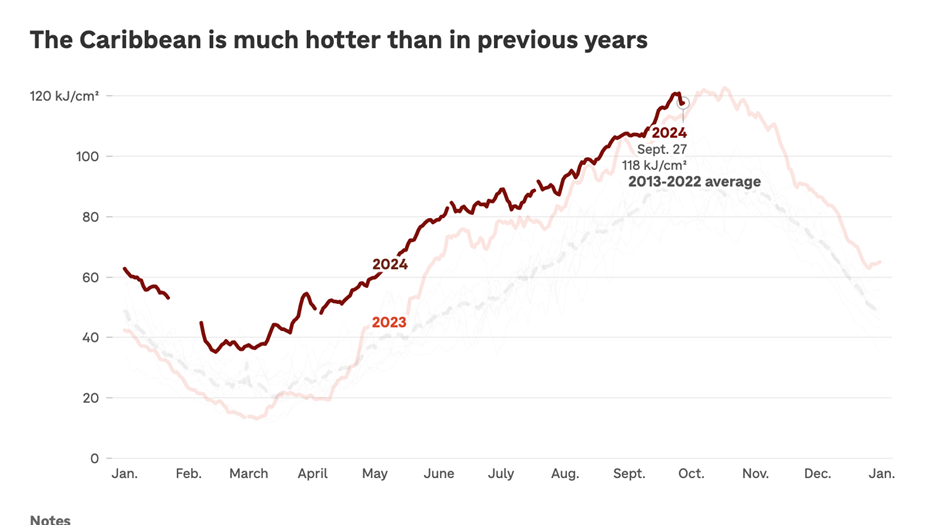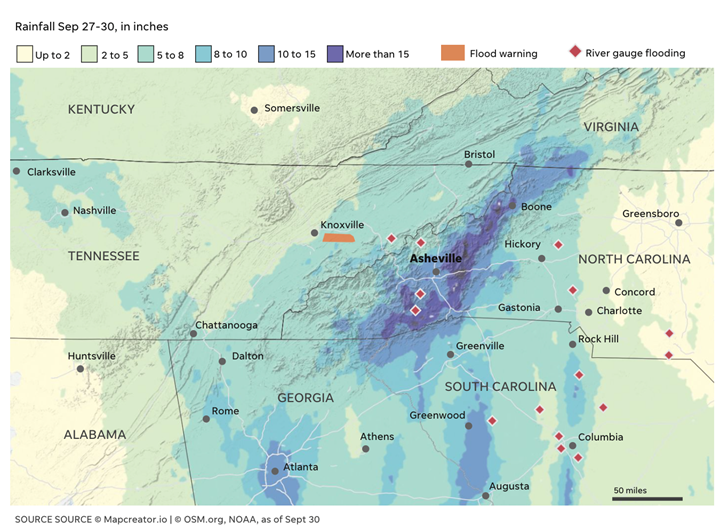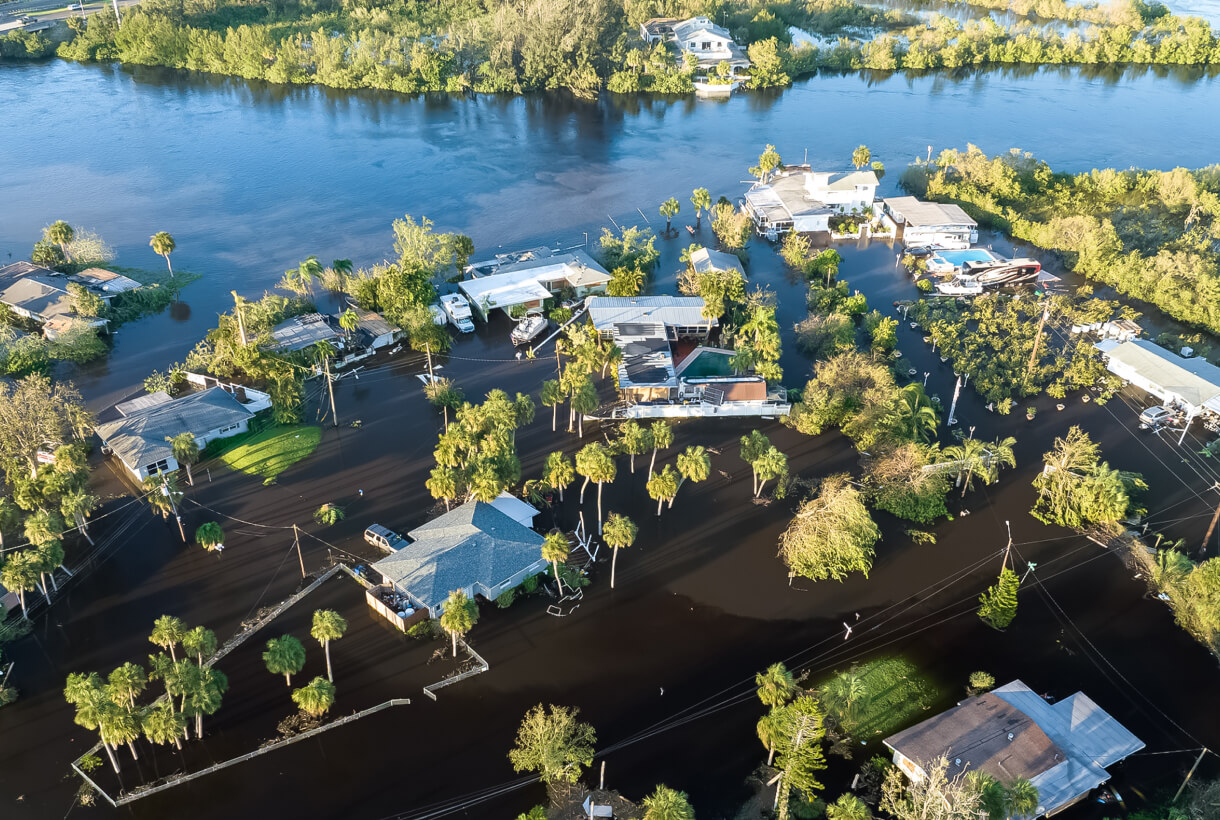The information in this blog is current as of Oct 2, 2024.
As the tragic stories from Hurricane Helene are becoming clear—a more general truth is also coming into focus: storm behavior continues to be stronger, and more unpredictable. For security and resilience practitioners, Dynamic Risk is on the rise.
The Role of Warmer Waters
Warm sea-surface temperatures in the Gulf provided the energy that drove Hurricane Helene. Figure 1 below shows the rise of temperatures, which could be thought of as “fuel”. These rising temperatures increased intensity, moisture supply, and sustained development for Helene:
- Increased Intensity: Warm waters, typically above 26°C (79°F), are crucial for hurricane development. The waters in the Gulf of Mexico were unusually warm when Hurricane Helene intensified, reaching temperatures around 85°F (29.4°C). This was approximately 1-2°C above normal, contributing significantly to the storm’s rapid strengthening as it approached the U.S. coast. (WUSF )(GPM Mission)

Figure 1. Rising Temperatures in the Gulf, Source: Brian McNoldy, University of Miami, Rosenstiel School of Marine, Atmospheric, and Earth Science, Credit: Daniel Wood/NPR
- Moisture Supply: Warm waters increase evaporation, which adds moisture to the atmosphere. This moisture is a key ingredient for a hurricane's convection processes, where warm, moist air rises, cools, and forms clouds and rain.
- Sustained Development: Even after Helene reached hurricane status, the warm waters helped maintain its strength over time. Hurricanes typically weaken when they encounter cooler waters or land, but as long as Helene – massive in scale - stayed over warm waters, it could sustain its intensity.
Flooding in Appalachia: The Effect of Terrain
The above factors, in combination with Appalachia’s unique mountain terrain, created “the perfect storm.”
- Predecessor rain: the soil was already saturated in these areas – before the worst of the hurricane.
- Mountainous terrain - particularly in western North Carolina - provided a “squeezing” effect, causing the hurricane to release the most rain in these areas.
- Steep slopes and shallow soil made the area particularly at risk for fast runoff, debris flows, and mudslides.
- Built infrastructure in valleys; because of the terrain, man-made development is constrained to areas adjacent to streams and rivers. Natural drainage systems were inadequate for the flooding waters.
Dynamic Risk in Action: Hurricane Helene
Dynamic risk refers to situations where the harm evolves or cascades, often diverging from initial expectations. This was exemplified in excruciating ways by the recent devastation caused by Hurricane Helene, underscoring the importance of adapting quickly and effectively to rapidly changing conditions. Small degree changes in the expected path on Thursday and Friday resulted in fast-moving decisions for resilience practitioners.
Hurricane Helene brought catastrophic flooding, particularly in Tennessee and the Carolinas. This storm highlighted the concept of dynamic risk—its impacts evolved in unexpected ways, intensifying in force and changing trajectory as it progressed.
Examples
- In Tennessee, delayed evacuation decisions led to a tragedy when 11 factory workers were swept away by floodwaters, resulting in fatalities and missing persons (Star Tribune). More broadly, many businesses had prepared for storm surges, but the unpredictability of flash floods overwhelmed those plans, revealing how crucial real-time risk management and rapid response can be.
- Similarly, North and South Carolina experienced cascading effects from the hurricane. In North Carolina, entire towns were cut off, with floodwaters damaging infrastructure, causing power outages, and creating health risks due to sewage contamination (Project HOPE). Cities and Towns in western North Carolina received more than a foot of rainfall over 27-30 September, with drainage structures unable to contain and manage the flows. (Figure 2)
- In South Carolina, coastal communities faced extensive flooding that impacted homes, businesses, and roadways, further demonstrating how risks can evolve beyond initial forecasts (Hernando Sun).

Figure 2. Rain from 27-30 September, Source: NOAA
Lessons for Risk and Resilience Leaders
Hurricane Helene’s evolving path and unexpected intensity serve as a critical reminder for risk and resilience professionals: dynamic risks require a flexible, adaptive response. This has implications for People, Process and Technology. Traditional approaches to hurricane preparedness may not be sufficient to address the unforeseen and growing secondary impacts. Organizations need to be ready for more than just the immediate aftermath.
Here are key lessons from Helene that businesses and governments may consider:
- Evacuation Timing Is Critical
The tragic delay in Tennessee’s factory evacuation demonstrates the dangers of waiting too long to act. Prioritizing the safety of employees; having preemptive plans in place; and running tabletop exercises in practice tend to lead to triggering evacuations before conditions worsen. - Cascading Risks Are Inevitable
As seen in both the Carolinas, the flooding from Helene created compounding risks—sewage overflow, health risks, and infrastructure damage. Planning for these cascading events, such as prolonged power outages and disrupted supply chains, must be a part of any emergency preparedness strategy. - Real-Time Risk Intelligence Is Essential
Organizations must rely on advanced tools for real-time risk monitoring. Critical Event Management (CEM) platforms allow for better tracking of a storm’s progress and potential impacts. AI-powered data pipelines analytics can help identify risks early, enabling quicker and more informed decision-making. - Community Resilience and Local Response
The response efforts in South Carolina highlighted the power of community resilience, with grassroots organizations quickly mobilizing to provide supplies and aid. This underscores the importance of public-private partnerships and community engagement in disaster response efforts.
Building Resilience in an Age of Dynamic Risk
To navigate these dynamic risks, organizations should adopt an adaptable, forward-thinking approach to hurricane risk management. This includes:
- Enhanced Data Analytics: Understanding past hurricane patterns and using predictive models to anticipate future risks.
- Rapid Communication: Implementing multimodal communication systems that ensure all stakeholders receive timely, critical updates.
- Preparedness Exercises: Conducting tabletop exercises to simulate worst-case scenarios and refine response strategies.
- Critical Event Management: Leveraging platforms that offer real-time data, quick communication tools, and flexible response capabilities to keep operations resilient during rapidly evolving situations.
The dynamic nature of risk – including hurricanes like Helene – continue to demand more from risk professionals. By adopting a proactive, flexible approach, organizations can not only weather the storm but also mitigate its long-term impacts on business continuity and safety.
Global businesses looking to navigate severe weather dynamic risks can reach out to us to learn more about our Critical Event Management solution.

